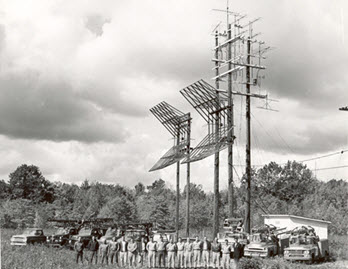Why Hasn't Cable Fought Harder Against Retrans Consent?

Cable television is rooted in the clear transmission of federally-licensed broadcast TV signals. The acronym CATV meant Community Antenna Television. In the late 1940s, in areas of the country where it was difficult or impossible to watch broadcast TV channels, cable lines were connected to a large antenna, often located on a mountain top, and then to poles in the community below. From there, to individual homes.
The arrangement was mutually beneficial. TV stations picked up viewers they did not already have, and that extended the reach of their advertising, increasing both revenue and ratings for the stations.
Remember, the public airwaves, that part of the electro-magnetic spectrum that includes television signals, are limited. Congress saw fit, when television came along, to mandate that TV stations operate in the “public interest, convenience and necessity.” As we all know, TV stations now operate low-margin businesses making billions of dollars for their media company owners.
Those giant, multibillion dollar companies will argue that local news is their contribution to the community. Local news on a station is a moneymaker. If it were not, local news would consist of 15 minutes of a talking head reading stories at 7 a.m. on Sunday mornings.
When cable grew in the 1970s and 80s, it was important to keep local broadcast signals available to those who no longer used “rabbit ears” to receive their local stations. “Must carry,” in that circumstance, makes sense. Cable operators complained that their First Amendment rights were being usurped in having to carry channels that they did not necessarily want. In this case, the public good overruled those objections. In effect, the government was protecting the “broadcast” of local TV stations.
Retransmission consent, where the cable operator is required to pay for the signal of federally-licensed use of the public airwaves, is an abomination. Cable operators must now pay for programming that is free over-the-air with the simple use of an antenna built into or connected to a television.
How did we get to this point? Why hasn’t the cable industry fought harder against this?
Early last year I left the cable TV industry involuntarily. After 35 years of free or deeply discounted cable services, I am now paying full price. One thing I noticed were the large fees for broadcast TV. In my case, $7.50 a month. And now the cable operator has announced that these fees are increasing!
$7.50 a month for broadcast channels that I could tune in without cable? Free, over-the-air publicly licensed stations. Wait! The retransmission consent fees are being used to produce more local news and community programming? Sadly, no. Retransmission fees are pure profit for the multibillion dollar media companies that own the stations.
Related: Murdochs Say Retrans Rates Could Rise 'Aggressively' at New Fox
The broadcast TV model worked just fine for decades without retransmission consent. Even with falling ratings the economics are unchanged. Look at Les Moonves and his $70 million salary. Or Ellen Pompeo’s new $20 million contract. Not to mention the $3.3 billion dollars Fox will be paying out over the next few years for the NFL on Thursday nights. Personally, I only made five figures annually in the TV business, nothing like the eight figures Moonves and Pompeo are pulling down. I may never work in the media industry again as I’m “overqualified” (too old).
Shouldn’t the federal government get all or a large portion of those retransmission-consent fees? That’s certainly worth the cost of a license to operate a station in the public interest, convenience and necessity on the public airwaves so these large companies can continue to profit, right?
Randy Smith is a former cable TV industry professional. Pictured: A Jerrold Electronics CATV tower in Meadsville, Pa., circa 1953; photo courtesy of The Cable Center, Barco Library.
The smarter way to stay on top of the multichannel video marketplace. Sign up below.
